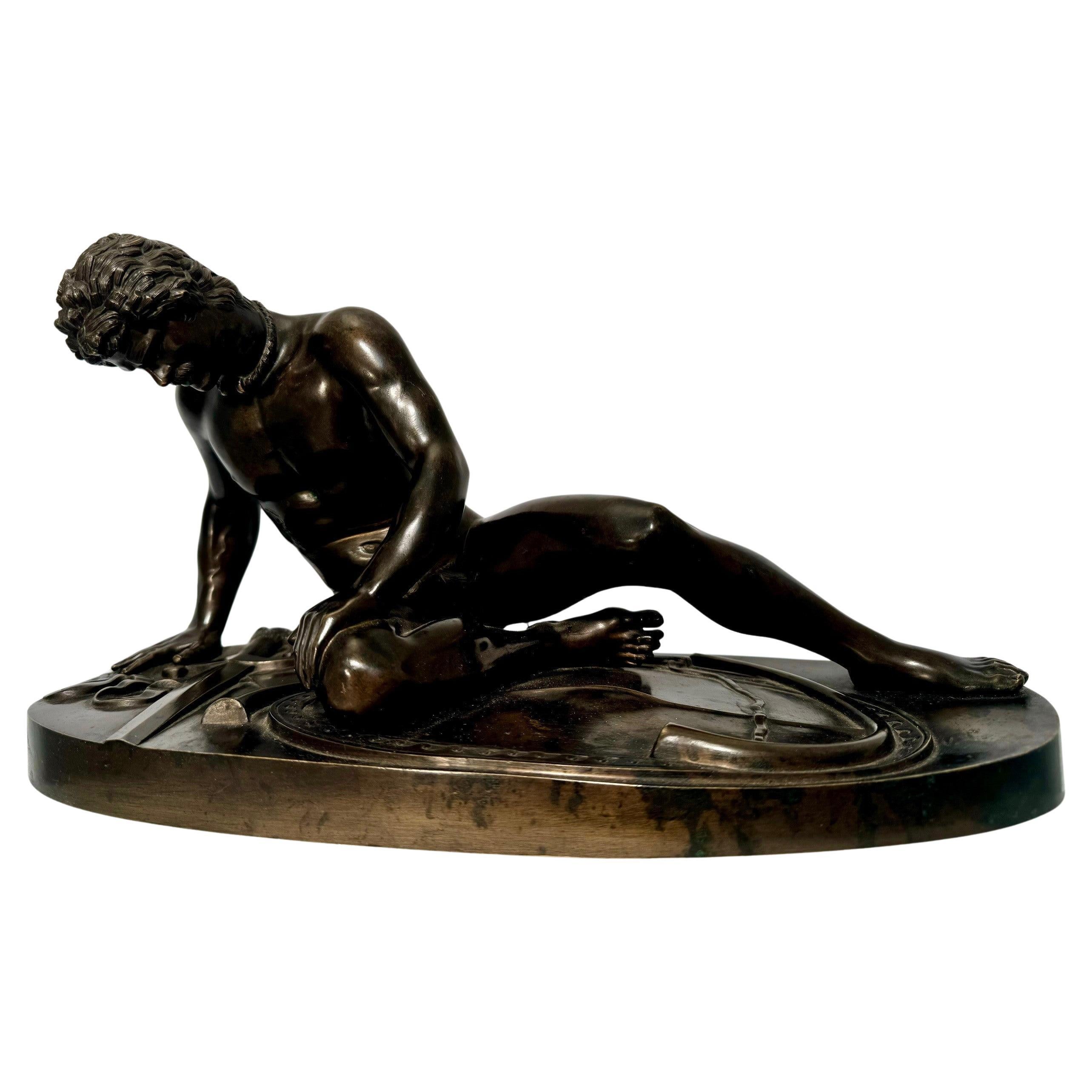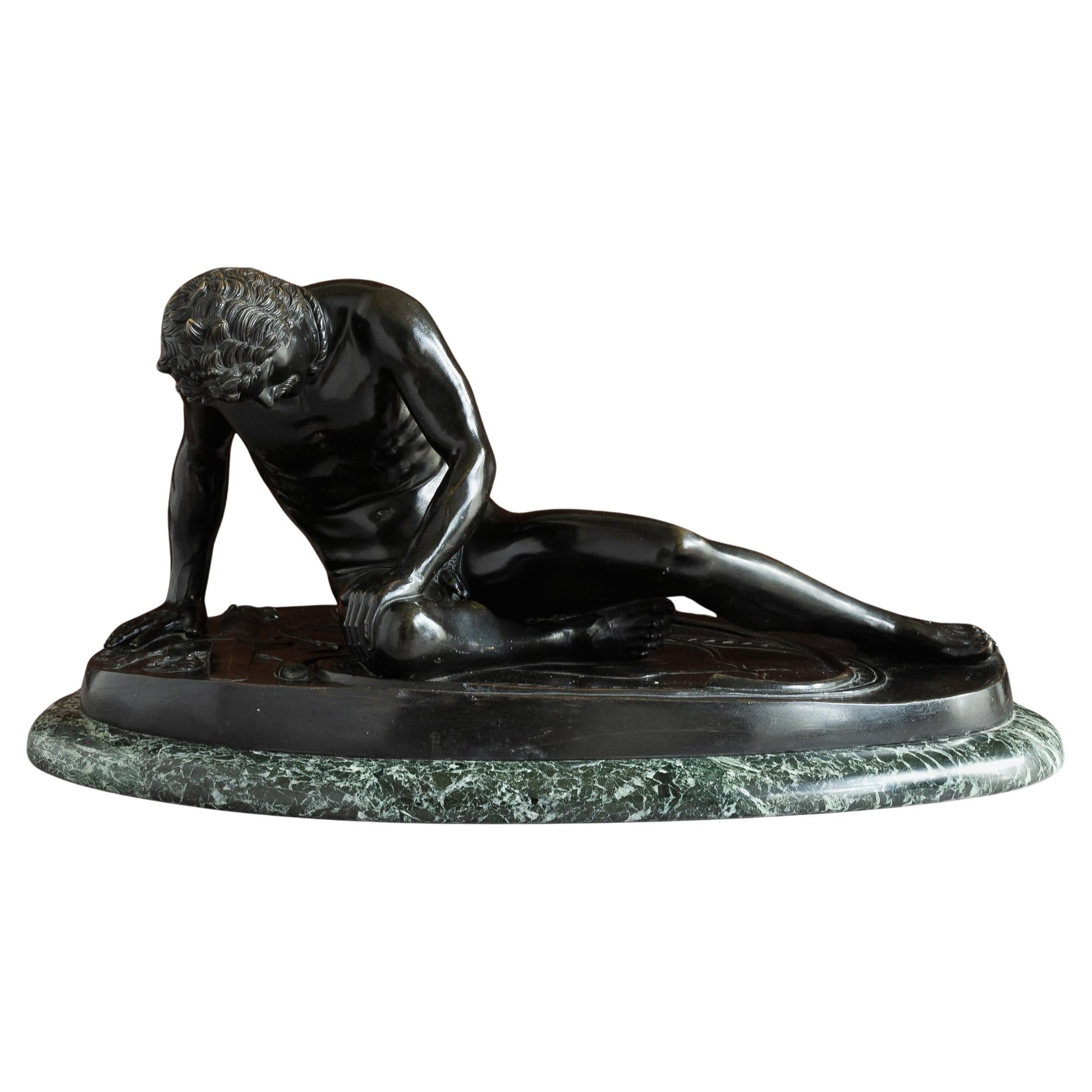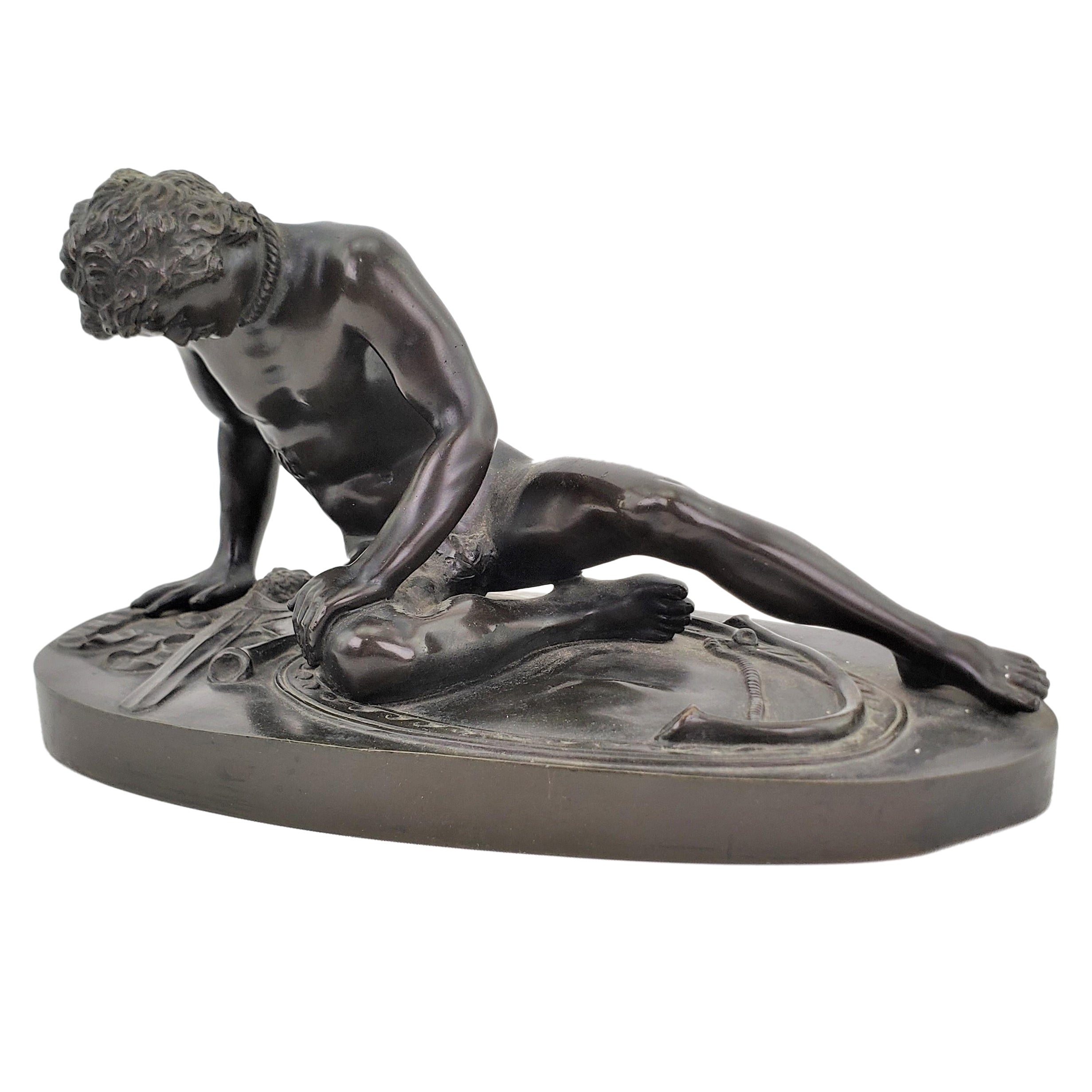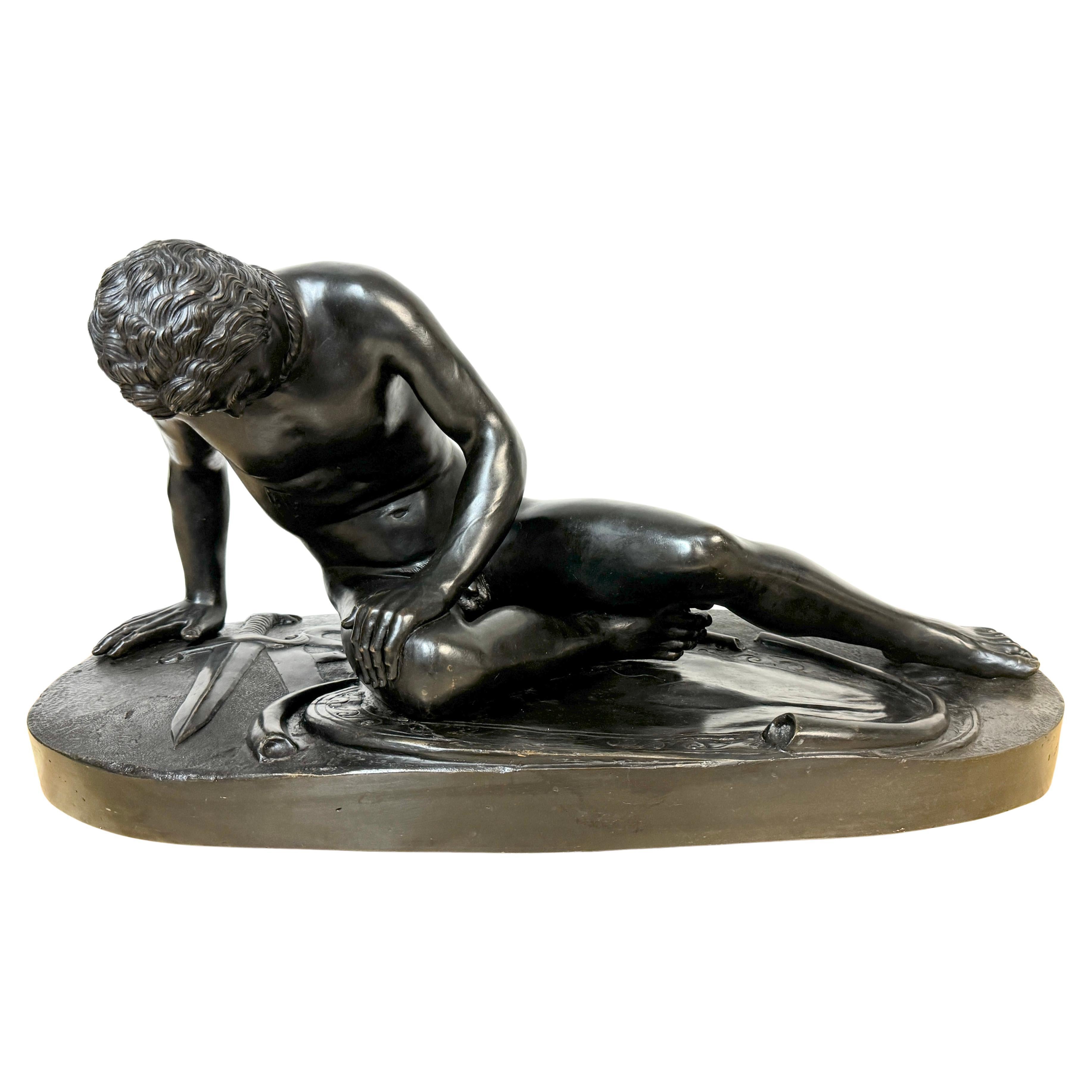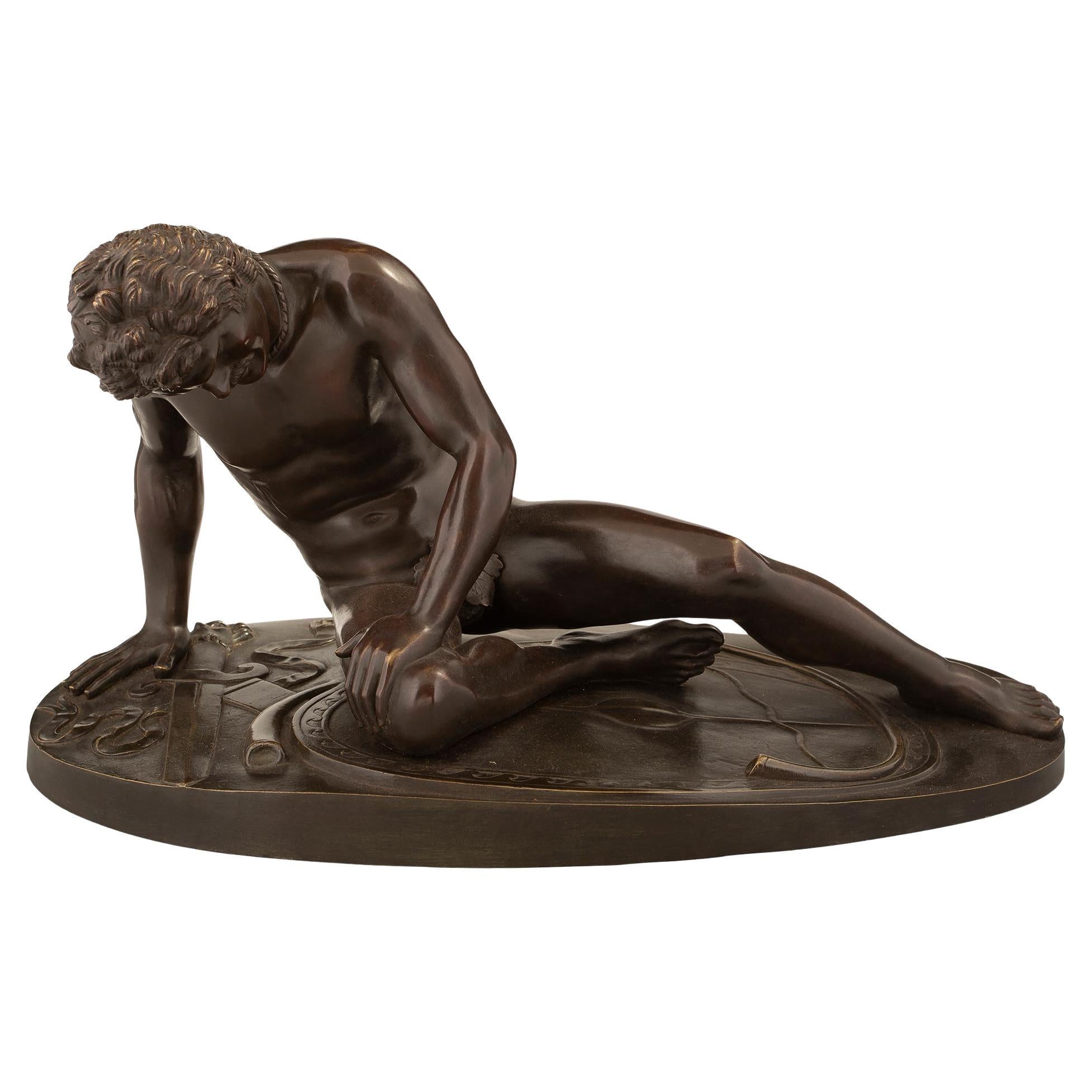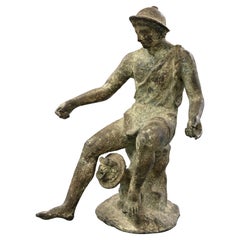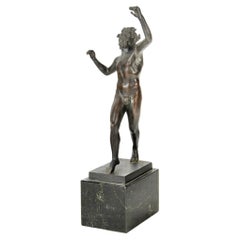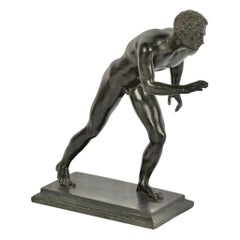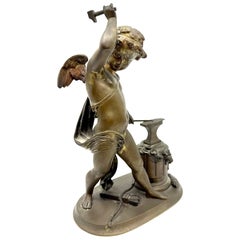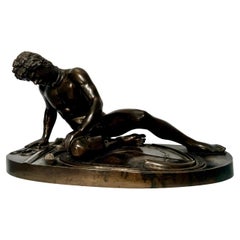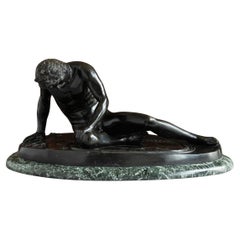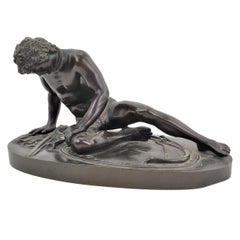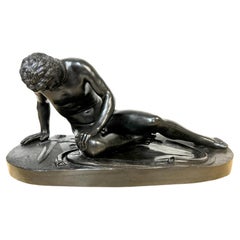Items Similar to Grand Tour Neoclassical Bronze of “The Dying Gaul”
Want more images or videos?
Request additional images or videos from the seller
1 of 16
Grand Tour Neoclassical Bronze of “The Dying Gaul”
$850
£642.01
€741.98
CA$1,192.26
A$1,326.09
CHF 694.05
MX$16,173.97
NOK 8,720.98
SEK 8,203.21
DKK 5,538.14
About the Item
A nice little bronze Grand Tour souvenir bronze of the Dying Gaul a famous sculpture of antiquity preserved in Rome. This bronze has nice detail. The patina is worn in some places and it is in estate found condition. We haven’t tried to clean or polish it.
Some patina loss minor nicks and surfaces scratches, please see the detailed photos.
For this interested this from Wikipedia about the original sculpture:
The Dying Gaul, also called The Dying Galatian[2] (Italian: Galata Morente) or The Dying Gladiator, is an ancient Roman marble semi-recumbent statue now in the Capitoline Museums in Rome. It is a copy of a now lost Greek sculpture from the Hellenistic period (323–31 BC) thought to have been made in bronze.[3] The original may have been commissioned at some time between 230 and 220 BC by Attalus I of Pergamon to celebrate his victory over the Galatians, the Celtic or Gaulish people of parts of Anatolia. The original sculptor is believed to have been Epigonus, a court sculptor of the Attalid dynasty of Pergamon.
Until the 20th century, the marble statue was usually known as The Dying Gladiator, on the assumption that it depicted a wounded gladiator in a Roman amphitheatre.[4] However, in the mid-19th century it was re-identified as a Gaul or Galatian and the present name "Dying Gaul" gradually achieved popular acceptance. The identification as a "barbarian" was evidenced for the figure's neck torc, thick hair and moustache, weapons and shield carved on the floor, and a type of Gallic carnyx between his legs.[5]
Description
The white marble statue, which may originally have been painted, depicts a wounded, slumped Gaulish or Galatian Celt, shown with remarkable realism and pathos, particularly as regards the face. A bleeding sword puncture is visible in his lower right chest. The warrior is represented with characteristic Celtic hairstyle and moustache with a Celtic torc around his neck. He sits on his shield while his sword, belt and curved trumpet lie beside him. The sword hilt bears a lion's head. The present base is a 17th-century addition. The nose and left arm restorations upon the discovery of the statue in the 17th century are contested (the right arm would be pushed even more behind his back).[6]
Discovery and expatriation
Back of the sculpture.
The Dying Gaul statue is thought to have been re-discovered in the early 17th century during excavations for the building of the Villa Ludovisi (commissioned by Cardinal Ludovico Ludovisi, nephew of Pope Gregory XV), on the site of the ancient Gardens of Sallust on the Pincian Hill in Rome. Many other antiquities (most notably the "Ludovisi Throne") were subsequently discovered[7] on the site in the late 19th century when the Ludovisi's estate was redeveloped and built over. The Dying Gaul was first recorded in a 1623 inventory of the collections of the Ludovisi family and in 1633 was in the Palazzo Grande, part of the Villa Ludovisi. Pope Clement XII (ruled 1730–1740) acquired it for the Capitoline collections. It was later taken by Napoleon's forces under the terms of the Treaty of Tolentino and was displayed with other Italian works of art in the Louvre Museum until 1816 when it was returned to Rome.
Portrayal of Celts
Detail showing his neck torc.
The statue serves both as a reminder of the Celts' defeat, thus demonstrating the might of the people who defeated them, and a memorial to their bravery as worthy adversaries. The statue may also provide evidence to corroborate ancient accounts of the fighting style—Diodorus Siculus reported that "Some of them have iron breastplates or chainmail while others fight naked".[8] Polybius wrote an evocative account of Galatian tactics against a Roman army at the Battle of Telamon of 225 BC:
The Insubres and the Boii wore trousers and light cloaks, but the Gaesatae, in their love of glory and defiant spirit, had thrown off their garments and taken up their position in front of the whole army naked and wearing nothing but their arms... The appearance of these naked warriors was a terrifying spectacle, for they were all men of splendid physique and in the prime of life.
— Polybius, Histories II.28
The Roman historian Livy recorded that the Celts of Asia Minor fought naked and their wounds were plain to see on the whiteness of their bodies.[9] The Greek historian Dionysius of Halicarnassus regarded this as a foolish tactic:
Our enemies fight naked. What injury could their long hair, their fierce looks, their clashing arms do us? These are mere symbols of barbarian boastfulness.
— Dionysius of Halicarnassus, History of Rome XIV.9
Detail showing the face, hairstyle and torc of the sculpture.
The depiction of this particular Galatian as naked may also have been intended to lend him the dignity of heroic nudity or pathetic nudity. It was not infrequent for Greek warriors to be likewise depicted as heroic nudes, as exemplified by the pedimental sculptures of the Temple of Aphaea at Aegina. The message conveyed by the sculpture, as H. W. Janson comments, is that "they knew how to die, barbarians that they were".[10]
Influence
The Dying Galatian became one of the most celebrated works to have survived from antiquity and was engraved[11] and endlessly copied by artists, for whom it was a classic model for depiction of strong emotion, and by sculptors. It shows signs of having been repaired, with the head seemingly having been broken off at the neck, though it is unclear whether the repairs were carried out in Roman times or after the statue's 17th-century rediscovery.[12] As discovered, the proper left leg was in three pieces. They are now pinned together with the pin concealed by the left kneecap. The Gaul's "spiky" hair is a 17th-century reworking of longer hair found as broken upon discovery.[13]
During this period, the statue was widely interpreted as representing a defeated gladiator, rather than a Galatian warrior. Hence it was known as the "Dying" or "Wounded Gladiator", "Roman Gladiator", and "Murmillo Dying". It has also been called the "Dying Trumpeter" because one of the scattered objects lying beside the figure is a horn.
The artistic quality and expressive pathos of the statue aroused great admiration among the educated classes in the 17th and 18th centuries and was a "must-see" sight on the Grand Tour of Europe undertaken by young men of the day. Byron was one such visitor, commemorating the statue in his poem Childe Harold's Pilgrimage:
I see before me the Gladiator lie
He leans upon his hand—his manly brow
Consents to death, but conquers agony,
And his drooped head sinks gradually low—
And through his side, the last drops, ebbing slow
From the red gash, fall heavy, one by one...[14]
The Dying Gladiator at Iford Manor, Wiltshire, England
It was widely copied, with kings,[15] academics and wealthy landowners[16] commissioning their own reproductions of the Dying Gaul. Thomas Jefferson wanted the original or a reproduction at Monticello.[17] The less well-off could purchase copies of the statue in miniature for use as ornaments and paperweights. Full-size plaster copies were also studied by art students.
It was requisitioned by Napoleon Bonaparte by terms of the Treaty of Campoformio (1797) during his invasion of Italy and taken in triumph to Paris, where it was put on display. The piece was returned to Rome in 1816.[17] From December 12, 2013, until March 16, 2014, the work was on display in the main rotunda of the west wing of the National Gallery of Art in Washington D.C. This temporary tenure marked the first time the statue had left Italy since it was returned in the second decade of the nineteenth century.[17]
- Dimensions:Height: 3 in (7.62 cm)Width: 6 in (15.24 cm)Depth: 3 in (7.62 cm)
- Materials and Techniques:
- Place of Origin:
- Period:
- Date of Manufacture:Early 20th Century
- Condition:Wear consistent with age and use. Minor losses. Some patina loss minor nicks and surfaces scratches, please see the detailed photos.
- Seller Location:Palm Springs, CA
- Reference Number:Seller: Bridges over Time DG207001stDibs: LU835044295642
About the Seller
5.0
Platinum Seller
Premium sellers with a 4.7+ rating and 24-hour response times
1stDibs seller since 2007
419 sales on 1stDibs
Typical response time: <1 hour
- ShippingRetrieving quote...Shipping from: Palm Springs, CA
- Return Policy
Authenticity Guarantee
In the unlikely event there’s an issue with an item’s authenticity, contact us within 1 year for a full refund. DetailsMoney-Back Guarantee
If your item is not as described, is damaged in transit, or does not arrive, contact us within 7 days for a full refund. Details24-Hour Cancellation
You have a 24-hour grace period in which to reconsider your purchase, with no questions asked.Vetted Professional Sellers
Our world-class sellers must adhere to strict standards for service and quality, maintaining the integrity of our listings.Price-Match Guarantee
If you find that a seller listed the same item for a lower price elsewhere, we’ll match it.Trusted Global Delivery
Our best-in-class carrier network provides specialized shipping options worldwide, including custom delivery.More From This Seller
View AllGrand Tour Souvenir Bronze of the Neapolitan Fisherman
Located in Palm Springs, CA
A lovely bronze antique sculpture of a fisherman after the antique excavated in Naples in the early 19th century. These Grand Tour Souvenirs were extremely popular in the 19th and ea...
Category
Early 20th Century Italian Figurative Sculptures
Materials
Bronze
German Foundry NeoClassical Grand Tour Bronze of the Neapolitan Dancing Faun
Located in Palm Springs, CA
A lovely and well cast example of the Pompeian Dancing Faun. This grand tour bronze stands approx 12 inches tall on it’s marble base and is about half size of the original unearthed...
Category
Early 20th Century German Figurative Sculptures
Materials
Bronze
19th Century Bronze of the Runner of Herculaneum with Panama Pacific Expo Label
Located in Palm Springs, CA
A nicely cast bronze Neoclassical Grand Tour souvenir of the Herculaneum Athlete or Runner. It’s nicely done with fine detail and has a Panama Pacific Exposition label on the base, w...
Category
Antique Late 19th Century Italian Figurative Sculptures
Materials
Bronze
19th Century Bronze Grand Tour Neoclassical Souvenir Cupid Making an Arrow
Located in Palm Springs, CA
A lovely bronze neoclassical Grand Tour Souvenir depicting Cupid fashioning and arrow on his anvil. The sculpture is after the antique. It is numbered. Most likely Italian. It has ni...
Category
Antique Late 19th Century Italian Figurative Sculptures
Materials
Bronze
Dancing Faun of Pompeii Bronze Grand Tour Souvenir
Located in Palm Springs, CA
A lovely and well cast example of the Pompeian Dancing Faun. This grand tour bronze stands approx 11.75 inches tall about half size of the original unearthed in Pompeii. Beautiful p...
Category
Early 20th Century Italian Figurative Sculptures
Materials
Bronze
Large Neo Classical Grand Tour Bronze of Satyr and infant Dionysus Bacchus
Located in Palm Springs, CA
A Large Neo Classical Bronze Grand Tour Sculpture depicting a Faun and Pan perhaps. I’ve seen this described as Satyr and the infant Dionys...
Category
Early 20th Century Italian Figurative Sculptures
Materials
Bronze
You May Also Like
Grand Tour bronze figure of “The Dying Gaul”, After The Antique
Located in Montreal, QC
A late 19th century Grand Tour bronze figure of “The Dying Gaul”, after the antique. The Dying Gaul depicts a warrior in his final moments, next to his shield and sword, his face contorted in pain just before he collapses from the mortal wound to his chest The original marble figure, which is in the Capitoline museum in Rome is thought to be a Roman copy of a Greek sculpture in Bronze. As an image of a vanquished enemy, the sculpture embodies courage in defeat, self-possession in the face of death, and the recognition of nobility in an alien race.
“The Dying Gaul” was found in Rome with another ancient marble...
Category
Antique Late 19th Century Italian Classical Greek Figurative Sculptures
Materials
Bronze
Antique Bronze Figure of The Dying Gaul
Located in London, GB
A bronze figure of the dying Gaul after the Antique, on verde marble base, Italian, nineteenth century.
Dimensions: 30.5cm (12") High, 35cm (13¾") Wide, 65cm (25½") Long, 13.5cm (5¼...
Category
Antique 19th Century Italian Classical Greek Figurative Sculptures
Materials
Marble, Bronze
Antique Grand Tour Ornately Cast 'The Dying Gaul' Italian Bronze Sculpture
Located in Hamilton, Ontario
This very ornately cast bronze sculpture is unsigned, but presumed to have been done in Italy in approximately 1900, in the Classical Roman style. This figurative study depicts the famous Classical Roman sculpture known as 'The Dying Gaul...
Category
Early 20th Century Italian Classical Roman Figurative Sculptures
Materials
Bronze
Large Italian Grand Tour Bronze Sculpture "Dying Galata" /Dying Gaul, C. 1875
Located in West Palm Beach, FL
Large Italian Grand Tour Bronze Sculpture "Dying Galata"/Dying Gaul, C. 1875, Attributed to Naples Foundry
A remarkable large Italian Grand Tour bronze sculpture titled "Dying Galata" or "Dying Gaul," dating circa 1875 and attributed to the renowned Naples Foundry. This exquisite piece, an expertly cast bronze, retains its original black-brown patina and boasts a substantial size, standing 12 inches high, 26.5 inches wide, and 13.5 inches deep. It is a distinguished example of the iconic Grand Tour sculptures, which were popular souvenirs for affluent travelers during the 19th century.
The sculpture is a faithful rendition of the ancient Roman marble statue "The Dying Gaul," also known as "The Dying Galatian" or "The Dying Gladiator." The original marble, now housed in the Capitoline Museums in Rome, is a Roman copy of a lost Greek bronze sculpture...
Category
Antique 19th Century Italian Grand Tour Figurative Sculptures
Materials
Bronze
Mid-19th Century Grand Tour Bronze Figurative Sculpture 'The Dying Gaul', Italy
Located in North Miami, FL
Mid-19th Century Grand Tour Bronze Figurative Sculpture 'The Dying Gaul', Italy
By: unknown
Material: bronze, copper, metal
Technique: cast, molded, polished, metalwork, patinated
D...
Category
Antique 1850s Italian Grand Tour Figurative Sculptures
Materials
Metal, Bronze, Copper
Italian 19th Century Patinated Statue of ‘The Dying Gaul’
Located in West Palm Beach, FL
A handsome Italian 19th century patinated statue of 'The Dying Gaul'. The statue is raised by an oval shaped terrain like designed base. The fallen gladiato...
Category
Antique 19th Century Italian Figurative Sculptures
Materials
Bronze
